Sponsored Content by SCIEXReviewed by Louis CastelSep 25 2025
This article describes the analysis of an LC-MS/MS method for over 600 pesticides and mycotoxins in a single injection using a rapid MRM acquisition rate approach on the SCIEX 7500+ system.
Good data quality was demonstrated with an MRM acquisition rate as low as 3 ms (1 ms dwell time and 2 ms pause time) while preserving instrument sensitivity, accuracy, and precision. In the solvent-based calibration standards, the majority of the analytes (89%) had limits of quantification (LOQ) of 1 ng/mL.
Figure 1 displays extracted ion chromatograms (XICs) for three pesticides at 1 µg/kg in soybean extract, indicating high sensitivity even at trace levels.
The SCIEX 7500+ system includes the new Mass Guard technology, which is intended to boost instrument robustness while maintaining optimal sensitivity, as well as the user-accessible DJet+ assembly, which provides cleaning flexibility1.
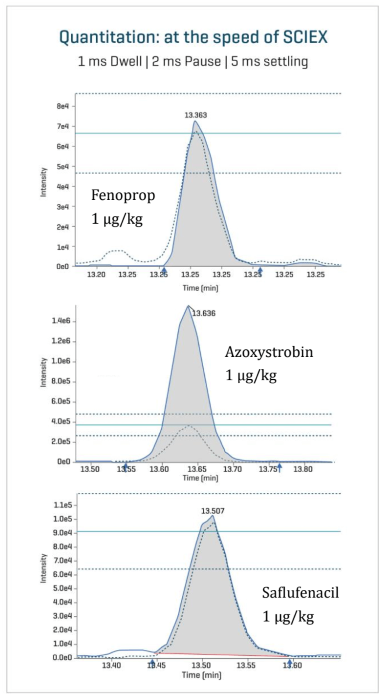
Figure 1. Overlaid XICs of 3 compounds at 1 µg/kg, acquired with a 1 ms dwell, 2 ms pause and 5 ms settling time in soybean extract. The images show overlaid quantifier and qualifier transitions for fenoprop, azoxystrobin and saflufenacil with ion ratio lines highlighting where the qualifier peak should sit to be within ±30 % ion ratio tolerance. Image Credit: SCIEX
Key benefits of the SCIEX 7500+ system for large panel contaminant analysis
- Fast MRM scan rate: A fast MRM scan rate of 3 ms (dwell and pause time) without compromising analytical performance. This allows for more compounds to be analyzed in a single injection while maintaining ion ratio stability.
- Continued high-end performance: Pesticides with an in-vial solvent LOQ of 1 ng/mL and injection volume of 1 µL demonstrated consistent high-end performance, resulting in decreased matrix effects.
- Positive and negative polarity switching: High-end performance was maintained with 5 ms settling time for both positive and negative polarity switching.
- Enhanced robustness and usability: Mass Guard technology extends instrument robustness and a DJet+ assembly to provide greater flexibility for user cleaning as necessary.
Introduction
Detecting pesticides in food is crucial for human health. The European Union (EU) regulates the presence of pesticides and mycotoxins in plant and animal-derived foods based on the maximum limits stated in regulations 396/2005 and 2023/915.2-3
These chemicals are commonly studied in food matrices with LC-MS/MS. However, assessing large analyte panels can be challenging depending on instrument speed - insufficient speed makes it difficult to monitor numerous concurrent chemicals while maintaining data quality.
In this technical note, the improved MRM acquisition rate of the SCIEX 7500+ system - as low as 3 ms per MRM - was utilized to evaluate 560 pesticides and 43 mycotoxins, resulting in 1,462 MRM transitions in a single injection. To keep things simple, only the pesticide results will be presented in this article.
The new Mass Guard technology enhances the system's robustness, while the DJet+ assembly allows for quicker and more routine user cleaning, minimizing the need for service interventions and enhancing instrument uptime.
Methods
Standard preparation: Individual analyte stock solutions were produced at 1 mg/mL in organic solvent. Spiking solutions were created by volumetrically diluting stock solutions with methanol or acetonitrile.
Spiked sample preparation: Representative samples from several categories were selected, including foods with high oil content (avocado), low oil content (soybean), and challenging or unique commodities (tea).
The matrices examined were lemon, mango, avocado, tea, and soybean. The samples were spiked at various concentrations (1, 3, 10, and 30 ppb) and extracted with the QuEChERS CEN technique.4 For cleanup, a Normec Groen Agro Control internal technique was used.
Chromatography: Separation was done using an ExionLC AD system from SCIEX and a Phenomenex Kinetex™ C18 (2.1 x 100 mm, 2.6 µm, 100 A) column (P/N: 00D-4462-AN).
A 28-minute gradient (including equilibration time) was utilized, with 0.1 % formic acid and 2 mM ammonium acetate in water for mobile phase A and 0.1 % formic acid and 2 mM ammonium acetate in methanol for mobile phase B (Table 1). The column temperature was kept at 50 °C with a flow rate of 0.3 mL/min and an injection volume of 1 μL.
Table 1. Chromatographic gradient for the analysis of pesticides and mycotoxins in food extracts using the SCIEX 7500+ system. Source: SCIEX
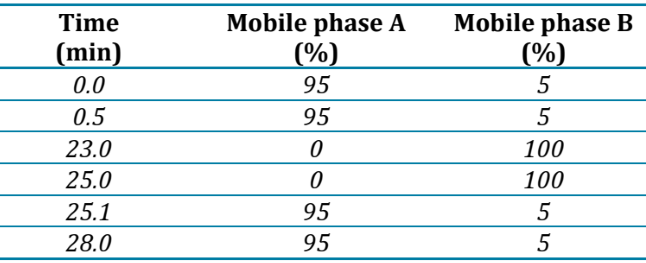
Mass spectrometry: Mass spectrometry data was collected using the SCIEX 7500+ system. The optimized source and gas parameters are shown in Table 2. The 560 pesticides and 43 mycotoxins were each subjected to optimized compound-specific MRM settings, resulting in 1,462 MRM transitions in a single injection.
Data processing: Data collection and analysis were done using SCIEX OS software 3.4.0.
Table 2. Source and gas parameters for the analysis of pesticides and mycotoxins in food extracts using the SCIEX 7500+ system. Source: SCIEX
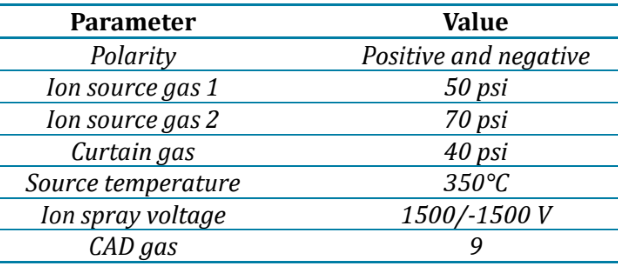
Fast MRM acquisition rate while maintaining sensitivity
When analyzing over 600 pesticides and mycotoxins in a single injection, instrument speed is critical to data quality - the instrument must have short cycle times and enough data points across the chromatographic peak.
The SCIEX 7500+ system can achieve dwell periods of less than 1 ms, pause times of less than 2 ms, and a settling time of 5 ms.
The practical ramifications of these fast rates include that each MRM transition requires only a 3 ms MRM acquisition rate, which, when paired with the Scheduled MRM algorithm, allows for the analysis of very large compound panels in a single injection.
To assess the MRM acquisition speed of the SCIEX 7500+ system, four alternative acquisition rates were used:
- Treatment 1: 2 ms dwell, 3 ms pause, and 15 ms settling
- Treatment 2: 2 ms dwell, 3 ms pause, and 5 ms settling
- Treatment 3: 1 ms dwell, 2 ms pause, and 5 ms settling
- Treatment 4: 1 ms dwell, 1 ms pause, and 5 ms settling
Across the entire range of pesticide analytes, the sensitivity of the SCIEX 7500+ system remained unaltered until the fastest acquisition rate (treatment 4) was utilized.
Figure 2 shows a comparison of the various rates, with butoxycarboxim as an example. The 1 ms dwell, 1 ms pause, and 5 ms settling time circumstances (treatment 4) resulted in a small (14 %) reduction in area count.
For this reason, future trials used the 1 ms dwell, 2 ms pause, and 5 ms settling time conditions (treatment 3). However, the data provided by treatment 4 may still be acceptable if the benefits of speedier acquisition outweigh the modest drop in sensitivity.

Figure 2. Sensitivity performance as a function of total acquisition rate for butoxycarboxim. The line graph (top) shows the peak area percent, normalized to the highest peak area, for butoxycarboxim at the 4 different acquisition rates: 2 ms dwell, 3 ms pause and 15 ms settling time (treatment 1); 2 ms dwell, 3 ms pause and 5 ms settling time (treatment 2); 1 ms dwell, 2 ms pause and 5 ms settling time (treatment 3) and 1 ms dwell, 1 ms pause and 5 ms settling time (treatment 4). The y-axis of the line graph is normalized to the area count in treatment 1. The graph shows a minimal area count decrease at the fastest acquisition rate. This trend is also shown in the XICs (bottom). Image Credit: SCIEX
Beyond instrument sensitivity, the MRM acquistion rate used in treatment 3 (1 ms dwell, 2 ms pause, and 5 ms settling time) demonstrated good data quality in terms of both precision and accuracy.
Figure 3 shows the precision (%CV) and accuracy over the solvent-based calibration curve (n=3) for three representative compounds: butoxycarboxim, methamidophos, and saflufenacil. The results indicate that the mean %CV was <10 % for all calibration standard levels in the three compounds, with a mean accuracy of 85 %-111 %.
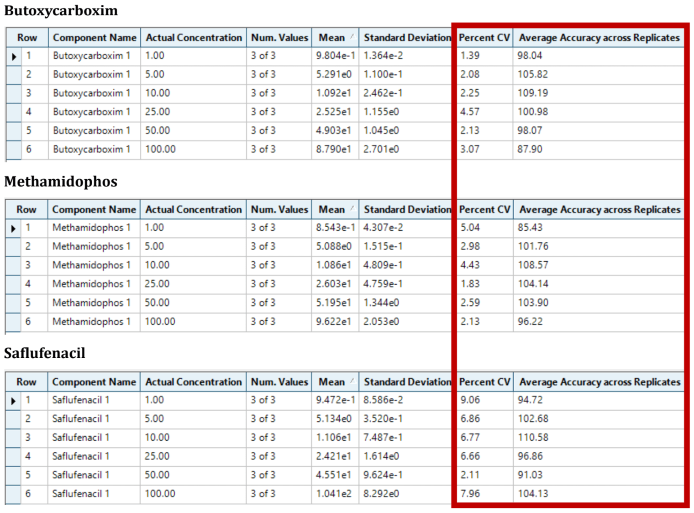
Figure 3. Accuracy and precision of the solvent-based calibration standards (n=3) for butoxycarboxim, methamidophos and saflufenacil using the acquisition conditions of 1 ms dwell, 2 ms pause and 5 ms settling time (treatment 3). The data showed good accuracy and precision across the calibration standard levels for all 3 compounds. The mean %CV was <10 % and the mean accuracy was 85 %–111 %. The concentration units are ng/mL. Image Credit: SCIEX
Finally, the MRM acquisition rate of 3 ms (dwell and pause time) allowed for more than 10 data points over the chromatographic peak, which is critical for reliable quantification.
Figure 4 shows XICs for three compounds: methamidophos, dimethoate, and triazophos, which were chosen based on their retention times covering the whole gradient. Despite the high level of analyte concurrency, the results contain sufficient data points.

Figure 4. Data points across the chromatographic peak for 3 example compounds using fast MRM acquisition rate conditions. The XICs demonstrate sufficient data points for good quantitation, even when using acquisition parameters of 1 ms dwell, 2 ms pause and 5 ms settling time (treatment 3). Image Credit: SCIEX
Trace-level sensitivity
The fast MRM acquisition rate (1 ms dwell, 2 ms pause, and 5 ms settling time) also showed low ng/mL (ppb) LOQ values for pesticides in solvent-based standards.
Figure 5 shows the LOQ breakdown in calibration standards for the 560 insecticides. The majority (89 %) of pesticides had a LOQ of 1 ng/mL, the lowest concentration tested, with 97.9% and 99.5 % obtaining LOQs of 5 ng/mL and 10 ng/mL, respectively.
The SCIEX 7500+ system demonstrated exceptional sensitivity, achieving low LOQs with only 1 µL injection. Food extracts benefit from low injection volumes to reduce matrix effects, and reduced matrix loads can assist prolong optimal instrument performance, decreasing instrument downtime and service intervention.
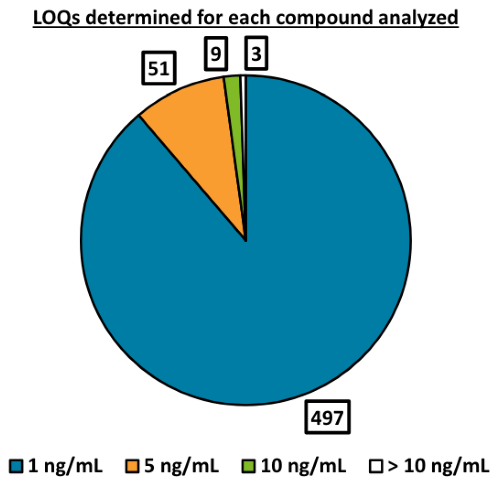
Figure 5. LOQs determined for 560 pesticide compounds analyzed within the mixed standard solution using the fast acquisition rate conditions of 1 ms dwell, 2 ms pause and 5 ms settling time. The chart above shows that most compounds (497) achieved an LOQ of 1 ng/mL with 51 and 9 providing LOQs of 5 ng/mL and 10 ng/mL, respectively. Image Credit: SCIEX
Figure 6 displays the superimposed XICs for 8 chemicals (4 in positive ion mode and 4 in negative ion mode) at the lowest concentration tested (1 ng/mL), demonstrating the system's sensitivity as well as the constant ion ratios observed.

Figure 6. Overlaid XICs of 8 different compounds (4 in positive ion mode and 4 in negative ion mode) at the lowest concentration analyzed (1 ng/mL) using the fast MRM acquisition conditions. The 3 XICs above show overlaid quantifier and qualifier transitions and ion ratio lines with a tolerance of 70 %–130 %. Image Credit: SCIEX
SCIEX 7500+ system performance in spiked samples
The rapid MRM acquisition rate approach (1 ms dwell, 2 ms pause, and 5 ms settling time) was tested in food matrix spikes (soybean, avocado, mango, lemon, and tea) at 1, 3, 10, and 30 µg/kg. Figure 7 shows carboxim (positive ion mode) and triclopyr (negative ion mode) at 1 µg/kg in all matrices.
This figure shows the sensitivity of the SCIEX 7500+ system and the utilization of two MRM transitions (qualifier and quantifier), with qualifier ion ratio tolerance lines ranging from 70 % to 130 %.
A retention time shift across the matrices was detected, with triclopyr exhibiting the greatest impact. Specifically, a portion of the triclopyr peak in the tea extract occurred outside of the retention time window.
Retention shifts can occur when studying complicated and diverse matrices, and the tea matrix data demonstrate a potential risk when completing acquisitions using the Scheduled MRM method with short retention time periods.
The fast acquisition rate of the SCIEX 7500+ system can mitigate this risk by allowing it to broaden the retention time window while maintaining relatively short cycle durations and adequate data points over the chromatographic peak.
Ultimately, this reduces the necessity for retention time management, as well as the frustration associated with sample reinjections to fix retention times.
The analysis used an external calibration curve (in solvent) to quantify all pesticide chemicals in the five matrices. Many of the target analytes showed acceptable recoveries in the 3 ppb spike (Figure 8).
The high sensitivity of the SCIEX 7500+ system enabled a 1 μL injection volume, decreased matrix effects, and maintained LOQs down to 1 µg/kg.
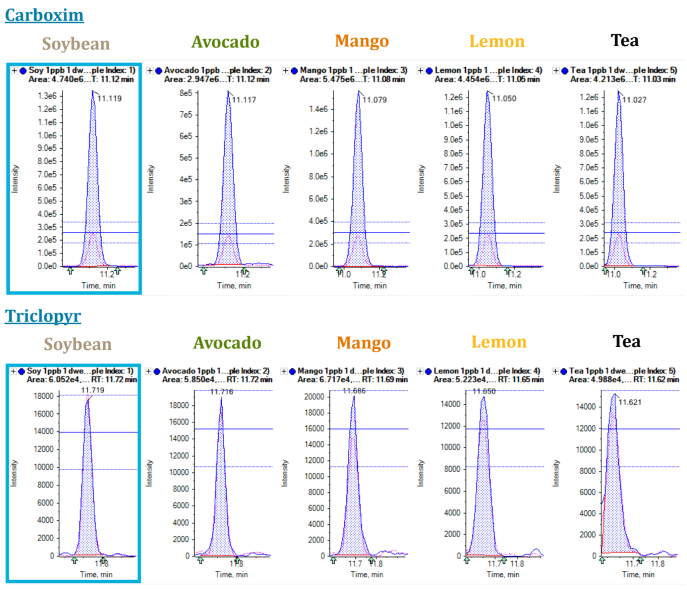
Figure 7. Overlaid XICs of carboxim and triclopyr at 1 µg/kg for all 5 matrices tested. The images show the sensitivity of the SCIEX 7500+ system along with overlaid quantifier and qualifier transitions with ion ratio lines depicting 70 %–130 % tolerances. The XICs illustrate the retention time shifting, which occasionally occurs when analyzing diverse and complex matrices. The potential risk of shifting outside of the retention time window can be mitigated by the fast acquisition rate of the SCIEX 7500+ system, which allows for increased retention time windows while maintaining sufficient data points across the chromatographic peak. Image Credit: SCIEX
Streamlined data processing using SCIEX OS software
Processing large data sets can be difficult and time-consuming. SCIEX OS software allows for custom calculations, data flagging, and filtering, which streamlines the data review process and ultimately saves time.
Figure 8 shows an example of a "Counter" column that calculates the number of matrices that met the 80 %-120 % accuracy requirements in 3 µg/kg spikes for each target pesticide. The "Counter" column can then be filtered to reveal only analytes that meet the accuracy criteria for all food matrices.
Alternatively, when the "Counter" column is set to "4", the results table displays pesticides for which a matrix violates the accuracy criteria. This example uses a custom filter to color matrices with poor accuracies (<80 %) blue and those with high accuracy (>120 %) red.
These customized, user-built features in SCIEX OS software help reduce the data review time by immediately viewing all matrices in a single results table and highlighting compounds that passed or failed the performance criterion. Custom computations can be adjusted to any data source, and there are several functionality options available.5
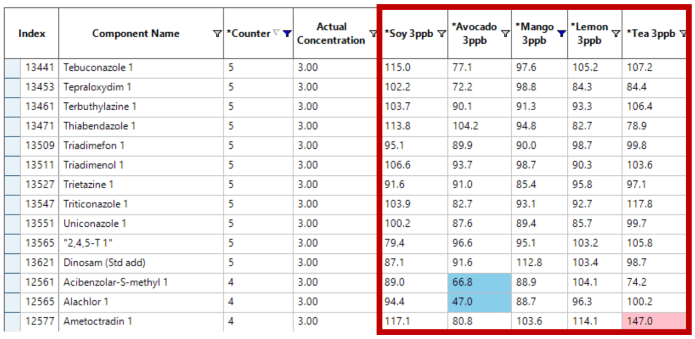
Figure 8. Easy implementation of custom calculations in SCIEX OS software to aid data review. This table illustrates how custom calculations and flagging rules can be implemented in SCIEX OS software to visualize which compounds fall within 80 %–120 % accuracy. Here, the “Counter” column is used to filter the data to show how many compounds have passed the accuracy criteria, with 5 indicating all criteria are met and 0 indicating none were met. The last 3 compounds listed show that flagging rules were applied due to accuracy values falling outside of 80 %–120 %. For quick and easy visualization, custom flagging rules have been used to shade cells with values <80 % in blue and cells with values >120 % in red. Image Credit: SCIEX
Instrument performance during unscheduled analysis
In addition to applying the Scheduled MRM algorithm for analysis, an unscheduled method was evaluated to determine the number of unscheduled MRM transitions conceivable given the system's increased speed.
Over 830 MRM transitions were used with a 1 s cycle time, which corresponds to a 0.5 ms dwell duration and 0.7 ms pause period. All data were acquired in the positive ion mode exclusively. Figure 9 depicts all transitions overlaid with selected samples to highlight individual substances (100 ng/ml).
This shows that sub-ms dwell and pause times are possible while maintaining acceptable performance.

Figure 9. Over 830 MRM transitions, collected using a 1 s cycle time, overlaid along with 3 highlighted examples. The top image shows all MRM transitions overlaid, and the bottom images show 3 chosen compounds - methamidophos, dimethoate and triazophos - from the total number of transitions analyzed. Image Credit: SCIEX
Conclusion
- The fast MRM acquisition rate of the SCIEX 7500+ system allows for more compound analysis in a single injection, with dwell and pause times below 1 ms while maintaining data quality.
- The majority (89 %) of compounds provided an in-vial solvent LOQ value of 1 ng/mL, indicating high sensitivity is attainable with the SCIEX 7500+ system.
- Matrix samples provide spiked LOQ values down to 1 µg/kg with minimal matrix effects.
- Custom calculations and layouts in SCIEX OS software can be utilized to simplify data review and processing.
References
- SCIEX. (2025). Setting a new standard for instrument resilience. Triple Quad 7500 Plus System. (online) Available at: https://sciex.com/products/mass-spectrometers/triple-quad-systems/triple-quad-7500-plus-system.
- European Union. (2024). Regulation (EC) No 396/2005 of the European Parliament and of the Council of 23 February 2005 on maximum residue levels of pesticides in or on food and feed of plant and animal origin. EUR-Lex - 02005R0396-20240226 - EN - EUR-Lex. (online) Available at: http://data.europa.eu/eli/reg/2005/396/2024-02-26.
- European Union. (2023). Commission Regulation (EU) 2023/915 of 25 April 2023 on maximum levels for certain contaminants in food. EUR-Lex - 02023R0915-20230810 - EN - EUR-Lex. (online) Available at: https://eur-lex.europa.eu/eli/reg/2023/915/2023-08-10.
- QuEChERS. QuEChERS: About the method. (online) Available at: https://www.quechers.eu/method.
- Custom calculation and filtering packages for SCIEX OS software based on EU guidelines. SCIEX technical note, MKT-30732-A. https://sciex.com/technotes/technology/custom-calculation-and-filteringpackages-for-sciex-os-software
Acknowledgments
This article was produced from materials originally authored by Jianru Stahl-Zeng1, Hassan El Khallabi2, Jack Steed3, Carlos Bueno4, and Ian Moore5.
1SCIEX, Germany
2Normec Groen Agro Control
3SCIEX, UK
4SCIEX, Spain
5SCIEX, Canada
The authors would like to thank Said El Ouadi (SCIEX) for helping to make this collaboration possible.
About SCIEX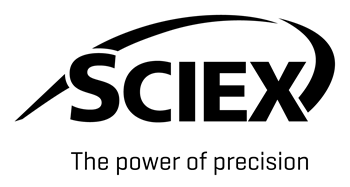
The SCIEX mission is to deliver solutions for the precision detection and quantitation of molecules, empowering our customers to protect and advance the wellness and safety of all.
SCIEX has led the field of mass spectrometry for 50 years. From the moment we launched the first ever commercially successful triple quad in 1981, we have developed groundbreaking technologies and solutions that ensure global food safety today.
Today, as part of the Danaher family of global life science and technology innovators, we continue to pioneer robust solutions in mass spectrometry and capillary electrophoresis. But we don’t just develop products. It is what we do together with our customers that sets them apart. That’s why thousands of food experts around the world choose SCIEX to get the answers they can trust and keep running - day in and day out with consistent performance.
We proudly stand behind our tagline: The Power of Precision.
Sponsored Content Policy: News-Medical.net publishes articles and related content that may be derived from sources where we have existing commercial relationships, provided such content adds value to the core editorial ethos of News-Medical.Net which is to educate and inform site visitors interested in medical research, science, medical devices and treatments.